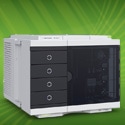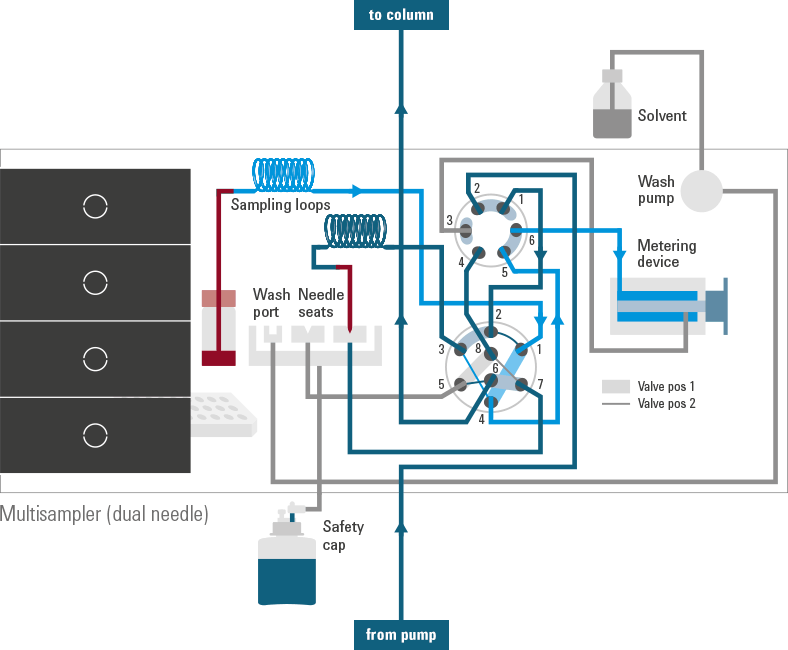Access Agilent eNewsletter March 2016

Dual-needle option for LC autosamplers provides improved speed, flexibility, and accuracy
Martin Greiner, Agilent Senior Product Manager, Analytical HPLC & CE
Liquid chromatography (LC) autosampler technology has long been available to assure unattended and reproducible injections in high-performance liquid chromatography (HPLC) analysis. Busy lab analysts have been requesting two specific upgrades to existing technology for quite a while: improved sample throughput with faster injection cycles and increased flexibility on injections without the need to change hardware parts. With the recent introduction of the dual-needle option available on the Agilent 1260 Infinity Multisampler and the Agilent 1290 Infinity II Multisampler, these demands can now be supported with a paradigm-changing level of speed, flexibility, and accuracy.

Figure 1. Agilent 1290 Infinity II Multisampler dual-needle flow path consists of a single metering device plus an additional valve support, two independent loops, and injection ports.
How the dual-needle setup works
The flow path of a standard autosampler usually consists of a needle to pierce vial septa or other sample container closures, a metering device to draw the correct volume of a sample from the container, a sample loop to host the sample volume within the HPLC flow path, a needle seat to tightly connect the needle (ensuring proper pressure and a leak-free connection to the LC path), and a valve to switch and connect the solvent flow and the autosampler flow path quickly and smoothly.
The Agilent dual-needle option provides two flow paths within one autosampler by doubling the needle, the sample loops, and the needle-seats, along with an additional valve. The dual-needle option is depicted schematically in Figure 1.
Increased throughput, flexibility and confidence
There are three main features of dual-needle technology that benefit laboratory analysts.
Throughput: When a dual-needle setup is used with two identical loops for left and right flow path, the instrument allows for alternating injections in short sequence. While the first needle and loop are connected to the LC-flow path and performing a separation run, the other needle and loop are disconnected and can be used for activities in the background of the ongoing separation. This could include moving to another sample container; drawing sample volumes into the loop; moving to a needle flush port (to wash the outside of the needle, reducing carryover); or going to the needle seat and preparing for injection.
The usual overhead time for injections can be reduced substantially when using a setup that allows for alternating column regeneration. This can result in reductions of total sequence times by up to 58% (time saved from run to run vs. sequential runs)[1]. Details on dual-needle analysis results are discussed in Agilent publication 5991-6150EN.
Flexibility: The increased flexibility of the dual-needle approach is palpable. You can extend the injection volume range without impacting the delay volume of the autosampler and without having to change hardware. Two different loop volumes can be used for the left and right flow paths.
For example, the right flow path could hold a typical analytical loop size of 20 µL, providing low dispersion and ideal fast chromatographic runs. The left flow path could be equipped with an up to 500 µL loop (for the 1290 Infinity II Multisampler) or even 900 µL loop (for the 1260 Infinity Multisampler) for large volume injections. Such large volume injections can be undertaken, even up to maximum system pressures depending on the instrument type (1300 bar or 600 bar). The dual-needle feature will deliver excellent linear dynamic ranges for injections from 0.1 µL to 900 µL.
Confidence: When two independent needle-seats, loops, and injection needles are available, you can chose which path should be used depending on the type of analysis being conducted. This could involve different injection paths for different applications. Additionally, it offers a safe reference or calibration path vs. a standard sample path. The dual-needle option will always provide a clean reference injection in case of troubleshooting or calibration tests.
Agilent delivers dual-needle autosampling technology that speeds analysis
The Agilent dual-needle option provides novel approach to autosampling, not just from a technological perspective, but from a practical one, as well. The dual-needle option provides increased flexibility that can support challenging tasks and deliver faster, more accurate analysis. The quantification performance allows an enhanced linear dynamic range for small to large sample volumes. Assuring comparability of injections from two different paths is supported by specially calibrated dual-needle loops.
Speed up run cycle times and shorten overhead times using the Agilent dual-needle feature. Maximum time savings are possible when smart overlapped injections are combined with automated column regeneration.
Agilent offers a wide array of LC, HPLC, and UHPLC solutions that will benefit all of your busy lab’s analysis needs. Contact your Agilent Representative today to find out more.
References
- Ultrafast Analysis of Food Preservatives Using Automated Column Regeneration and Dual-Needle Injection, Agilent Application Note 5991-6150EN.
Stay informed about the applications that are important to you
Subscribe to Access Agilent
Our free customized
monthly eNewsletter
Article Directory – March 2016
All articles in this issue
 Evolution of multiple heart-cutting 2D-LC: Agilent 1290 Infinity II provides high-resolution sampling and easy quantitation
Evolution of multiple heart-cutting 2D-LC: Agilent 1290 Infinity II provides high-resolution sampling and easy quantitation Tip: How to achieve efficient, effortless LC method transfer to the Agilent 1290 Infinity II LC System
Tip: How to achieve efficient, effortless LC method transfer to the Agilent 1290 Infinity II LC System Agilent 1290 Infinity II RID delivers high resolution and rapid polymer characterization
Agilent 1290 Infinity II RID delivers high resolution and rapid polymer characterization Dual-needle option for LC autosamplers provides improved speed, flexibility, and accuracy
Dual-needle option for LC autosamplers provides improved speed, flexibility, and accuracy Multiple heart-cutting 2D-LC/MS method for reproducible resolution of chiral drug metabolites
Multiple heart-cutting 2D-LC/MS method for reproducible resolution of chiral drug metabolites Quick, accurate screening for suspect environmental contaminants with Agilent solutions
Quick, accurate screening for suspect environmental contaminants with Agilent solutions
Figure 1

Agilent 1290 Infinity II Multisampler dual-needle flow path consists of a single metering device plus an additional valve support, two independent loops, and injection ports.